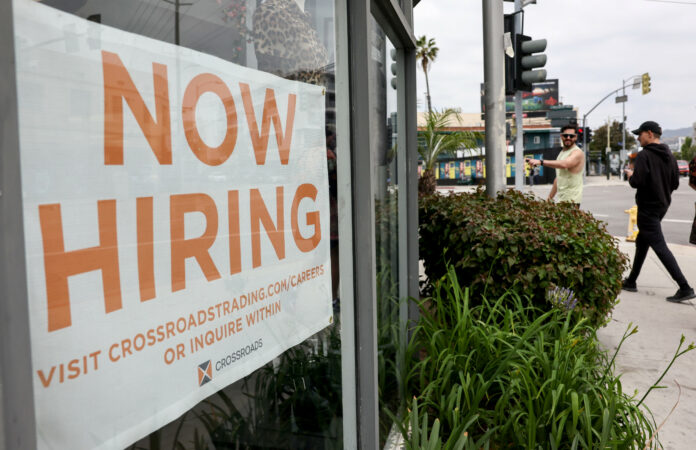Employers held back on hiring in November and workers chose to stay put at their current jobs as Americans brace themselves for layoffs in the coming year. Job openings are down even as four in 10 employers say they’re expecting to lay off workers this year.
Job openings ticked down slightly in November to about 8.8 million compared to last month’s 8.85 million and was lower from a year ago when it stood at nearly 11 million, data from the U.S. Bureau of Labor Statistics showed on Wednesday.
“The labor market is starting to stabilize,” Kory Kantenga, a senior economist at LinkedIn, told Newsweek. “We see that hiring and quits have also stabilized and layoffs remain historically low.”
A recent survey from Resume Builder suggests layoffs may be imminent, with half of the 900 companies surveyed citing an anticipated recession as the reasoning behind headcount reductions.
MARIO TAMA/GETTY IMAGES
Employees choosing to stay put at their current roles suggests an end of the so-called “Great Resignation,” seen immediately after the economy reopened during the pandemic, when workers were prepared to quickly switch jobs.
“The number of monthly hires fell to the lowest level since 2017 outside the pandemic,” Julia Pollak, ZipRecruiter’s chief economist, told Newsweek. “The slowdown in hiring was clearly felt by workers, who sheltered in place in their current jobs and exhibited less job hopping.”
Separations, which is the Bureau of Labor Statistics’ way of capturing the number of people who are leaving their jobs either because they are being let go or are quitting, decreased in November. Quits fell to 3.5 million while layoffs were unchanged for the month.
“Essentially, people aren’t starting new jobs, they aren’t leaving. Instead of the great resignation we had a few years ago, we have more of a great stay,” labor economist Guy Berger told Newsweek. “People are just hunkering down, companies are not bringing in new workers but they’re holding on to their old workers.”
Some industries that have been at the forefront of hiring in 2023 showed signs of cooling in November. Government job openings decreased by nearly 60,000, while roles in transportation, warehousing and utilities fell by 128,000.
Should the trend of hiring from the federal government continue to slow, it could suggest a labor market with fewer openings for workers.
Jobs Outlook for 2024
“State, local and federal government, they’ve been driving a fair amount of job growth in the last year. That’s kept some of the labor market resilience,” Kantenga said. “If we start to see government roles less frequently posted, then we’ll start to see job openings come down.”
Employers are waiting to see what the Federal Reserve does with interest rates before deciding what to do with their workers, he added.
Fed policymakers held interest rates for the third time in a row at their meeting in December after instituting the most aggressive series of hikes since the 1980s to slow record-high inflation. The jump in rates pushed up borrowing costs, which have affected business investment.
But hiring managers are keen on retaining their employees, aware of how tough it has become to find talent.
“Right now, there are some employers out there who are probably thinking, ‘Well, the economy has been very resilient, things might pick up again, I am not going to let go of my workers in case I actually do end up needing them,'” Kantenga said. “So, there is this push-pull of employers trying to navigate the uncertainty about what’s going to happen with the economy in 2024.”
Fed policymakers indicated last month that they may cut rates to 4.6 percent from their current level of 5.25 to 5.5 percent, but it’s unclear when that might happen. Kantenga suggested that the cuts may come in the spring or summer. Should rates stay high, that could have a knock-on effect on the labor market with a chance for layoffs.
“Employers are holding on to workers because they’re not really sure how this is going to go, whether we’re gonna start picking up again or they’re gonna slow down more,” Kantenga said. “If we do start to slow down more, you might see employers making that decision to let more workers go.”
Pollak suggested that the company’s online job postings were showing that hiring may continue to slow during the first quarter of 2024.
“Many of the changes to hiring plans that companies made in 2023 will only be fully felt in 2024,” she said.
She pointed out that there are anecdotal signals of a cooling labor market, such as news that consulting firm McKinsey has reduced the size of its 2024 partner class by 35 percent.
“Businesses overall are projecting that they’ll hire fewer members of this year’s graduating class of 2024 than they did of last year’s,” Pollak added.
Nancy Vanden Houten at Oxford Economics pointed out that cooling inflation, which in November was at 3.1 percent, much lower than the 9 percent in June 2022, may spur the Fed to cut rates in May or June.
“Job openings fell, new hires declined and the quits rate slipped to the lowest since September 2020, a sign that wage pressures will continue to ease,” she said.
If the Fed brings down rates sooner rather than later, companies may throw caution to the wind when it comes to hiring.
“The cautious mood among hiring managers could change later in the year, however, if inflation continues to cool and the Fed is able to start lowering interest rates,” Pollak said. “Investments that don’t currently pencil out in a high-rate environment might get the green light once financial conditions improve.”
Uncommon Knowledge
Newsweek is committed to challenging conventional wisdom and finding connections in the search for common ground.
Newsweek is committed to challenging conventional wisdom and finding connections in the search for common ground.


